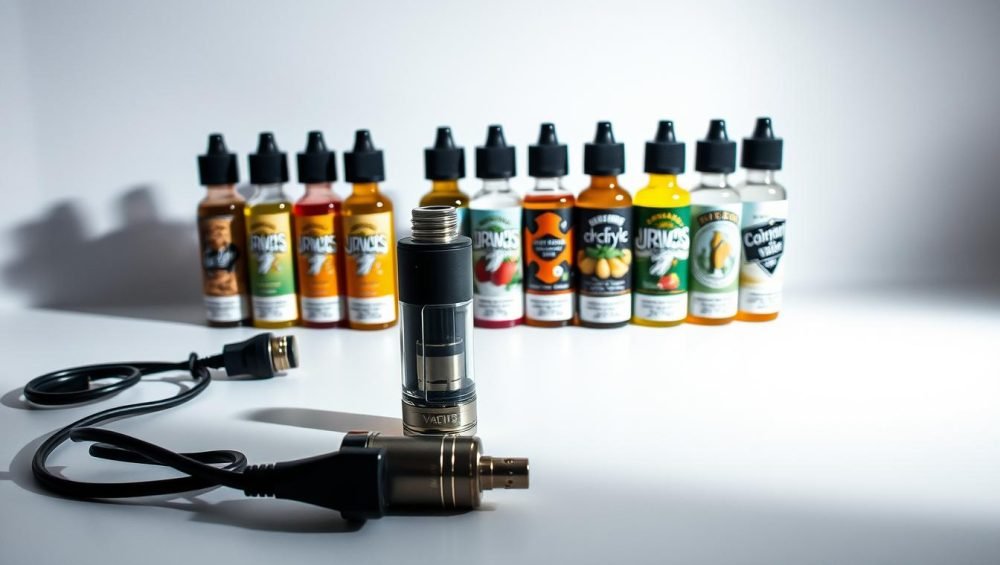Welcome to my personal guide to getting started in the world of vaping. If you are new to this scene, you are in the right place.
Especially at the beginning, the variety of e-cigarettes can seem overwhelming. But don't worry, I am here to pave the way for you. Particularly Disposable E-Cigarettes have proven to be ideal solutions for beginners because they are easy to handle and require no maintenance.
Our shop, https://www.elementvape.de/, offers a wide selection of starter kits and disposable e-cigarettes. If you have any questions, do not hesitate to contact us via email at [email protected].
In this article, I focus on pod-based systems, which are particularly popular due to their simplicity and efficiency. Based on my own experiences and research, I give you an overview of the best products and tips for the perfect start.
So, let's dive into the world of vaping together and discover what options are available to you. In the following sections, we will go into detail and find the right starter kit for you.
Introduction to the world of pod e-cigarettes
My journey into the world of vaping began a few years ago when I was looking for a simple alternative. Pod e-cigarettes immediately fascinated me because they require no maintenance and are extremely user-friendly.
A pod is essentially a replaceable cartridge filled with e-liquid. Compared to traditional e-cigarettes, they offer more convenience and are therefore ideal for beginners.
| Features | Pod systems | Traditional e-cigarettes |
|---|---|---|
| User-friendliness | Very simple | Moderate |
| Maintenance | No maintenance | Regular maintenance |
| Steam | Light vapor | Stronger vapor |
Today's technology has made vaping even more enjoyable. Modern pods are equipped with safety features that make starting especially safe.
What is a pod?
Before we dive deeper into the world of vaping, it's important to understand the basic concepts. One of the central elements of modern e-cigarettes is the so-called pod.
Definition and functions
A pod is essentially a replaceable container filled with e-liquid. Similar to technical systems where pods serve as containers for resources, this container functions as a core component of the e-cigarette. It is equipped with a heating element that heats the e-liquid and converts it into vapor.
The technology behind a pod is simple but effective. The user only needs to insert the pod into the device and activate it. This system is characterized by its user-friendliness and low maintenance requirements.
Pod vs. traditional e-cigarettes
Compared to conventional e-cigarettes, pod-based systems offer numerous advantages. Traditional e-cigarettes require regular maintenance, such as refilling e-liquid or cleaning the atomizer. With pod systems, this effort is eliminated because the pod is simply replaced when it is empty.
Another advantage of pod systems is the variety of flavors available. This makes them especially attractive for beginners who are not yet sure which flavor they prefer.
| Features | Pod systems | Traditional e-cigarettes |
|---|---|---|
| User-friendliness | Very simple | Moderate |
| Maintenance | No maintenance | Regular maintenance |
| Steam | Light vapor | Stronger vapor |
| Flavor | Many options | Fewer options |
Today's technology has made vaping even more enjoyable. Modern pod-systems are equipped with safety features that make starting especially safe. The ease of use and the variety of flavors make pod-systems an ideal choice for beginners.

The benefits of vaping with disposable e-cigarettes
Disposable e-cigarettes offer a variety of advantages that make them an ideal choice for beginners. Besides their ease of use, they impress with their compact design and low maintenance requirements.
Practicality for beginners
For beginners, disposable e-cigarettes are particularly suitable because they require no preparation or maintenance. The user simply needs to take the device out of the packaging and use it. This minimizes fears and uncertainties that newcomers often have when handling new devices.
Another advantage is the variety of flavors available. This allows beginners to try different aromas without having to commit to a specific taste experience.
Health Aspects and Safety
Disposable e-cigarettes are equipped with modern safety technologies that make the consumption of e-liquid safer. Regulatory authorities like the European Union have issued strict guidelines for the approval of e-cigarettes to ensure consumer safety.
Additionally, disposable e-cigarettes are more environmentally friendly than traditional e-cigarettes because they do not require reusable components like batteries or atomizers. This reduces waste and makes them a more sustainable option.
| Features | Disposable E-Cigarettes | Traditional e-cigarettes |
|---|---|---|
| User-friendliness | Very simple | Moderate |
| Maintenance | No maintenance | Regular maintenance |
| Steam | Light vapor | Stronger vapor |
| Flavor | Many options | Fewer options |
Disposable e-cigarettes are not only practical but also a cost-effective solution. Since no additional devices or maintenance are required, they are an attractive option for those who want to get started easily.
Technology and Functionality of Pod E-Cigarettes
The technology behind pod e-cigarettes is a masterpiece of modern engineering. They combine user-friendliness with advanced technology to provide a safe and enjoyable vaping experience.
Construction and Technical Details
Pod e-cigarettes consist of a few carefully designed components. The pod itself is a replaceable container filled with e-liquid and equipped with a heating element. This heating element is electronically controlled to produce optimal vapor.
The materials used for manufacturing are of the highest quality. For example, pods are often made from food-grade plastic, while the heating elements are made of stainless steel or ceramic. This construction ensures durability as well as consistent vapor quality.
Innovative Safety Technologies
Safety is a top priority for pod e-cigarettes. Modern devices are equipped with numerous safety features, such as overheat protection, short circuit detection, and protection against deep discharge of the battery. These technologies ensure risk-free vaping.
Another innovation is the automatic draw detection sensor. Once the user inhales, the device activates and produces vapor. This sensor is not only practical but also reduces energy consumption when the device is not in use.
| Technical Details | Pod E-Cigarettes | Traditional e-cigarettes |
|---|---|---|
| Heating Element | Ceramic or Stainless Steel | Metal |
| Safety Features | Overheat Protection, Short Circuit Detection | Limited Safety Features |
| Battery | Automatic Shut-off | Manual Control |
The combination of high-quality materials and intelligent safety technologies makes pod e-cigarettes a reliable companion for beginners and experienced vapers alike. The technology is designed to be both user-friendly and efficient.

Product variety and application possibilities
The world of e-cigarettes is diverse and offers a wide range of products that cover different needs. Especially in current times, pod-based systems have proven to be particularly popular.
Different types of pods
There are various types of pod systems that differ in their construction and functionality. Some are designed for discreet use, while others are built for stronger vapor production. Each type offers special advantages, whether through compact size or a variety of flavors.
Examples of everyday use
Pod devices are indispensable in daily life. Whether on the go or during leisure time, they offer a flexible solution. Disposable e-cigarettes are especially practical because they require no maintenance and are easy to transport. I personally swear by different pod types that provide the perfect alternative depending on the situation.
Continuous technological development has significantly enriched the market in recent times. Through these innovations, vapers can constantly improve their experience and discover new things.
Modern trends in vaping
The world of vaping is in constant evolution, and current trends clearly show the direction in which the industry is developing. New technological developments and changing user preferences shape the modern vaping experience.
Impact of current developments
Technology plays a central role in shaping today's vaping experience. Modern pod systems are equipped with advanced safety features that make consumption not only safer but also more enjoyable. Through automatic temperature regulation and overheat protection, a controlled vapor is created that excites both beginners and experienced vapers.
Another trend is the Variety of flavors, which are specifically developed for pod systems. These allow users to personalize their vaping experience without compromising on quality.
Future prospects in the e-cigarette market
Looking into the future, sustainability will play an increasingly important role. Many manufacturers are already working on recyclable materials for pod systems to reduce environmental impact. This development will not only increase the acceptance of e-cigarettes but also lead to a more sustainable industry.
| Aspect | Traditional methods | Pod-based approaches |
|---|---|---|
| User-friendliness | Moderate | Very simple |
| Safety | Limited | Extended |
| Flavor | Limited | Variety |
| Sustainability | Low | High Focus |
The combination of innovative technologies and ecological thinking will shape the e-cigarette market in the coming years. Pod-Systems are already a perfect example of how progress and user-friendliness can go hand in hand today.
Tips and personal experiences for getting started with vaping
As someone who started vaping years ago, I want to share my experiences and provide valuable tips to make the entry easier.
My first experiences with pod e-cigarettes
My journey began with a simple Pod e-cigarette. I was looking for an alternative that required no know-how. The user-friendliness convinced me immediately – just insert the pod and get started.
Initially, I had difficulty finding the right flavor, but the variety of options helped me discover my perfect aroma.
Recommendations for beginners
For beginners, I recommend high-quality, safe devices. Disposable e-cigarettes are ideal because they require no maintenance and are portable everywhere.
A common mistake is overlooking safety features. Make sure your device offers overheat protection and automatic shut-off.
| Aspect | Pod-based systems | Traditional e-cigarettes |
|---|---|---|
| User-friendliness | Very simple | Moderate |
| Maintenance | No maintenance | Regular maintenance |
| Flavor | Many options | Fewer options |
Disposable e-cigarettes offer a convenient solution that makes it easier to get started with vaping. With these tips, you can easily start exploring the world of vaping.
When I started vaping years ago, I was looking for a simple and safe alternative. Today, I see how technology has evolved and how pod-based systems have made it even more attractive for beginners.
Disposable e-cigarettes are not only practical but also safe. They require no maintenance and offer a variety of flavors. The innovative technology of the time has made vaping even more enjoyable and accessible.
I personally see a promising future for the e-cigarettes market. Sustainability and advanced safety features are becoming increasingly important. My tip for beginners: start with high-quality devices and explore the variety of flavors.
The combination of simple handling and innovative technology makes vaping particularly attractive today. Be inspired by the advantages of pod technology and explore the world of vaping.




























































